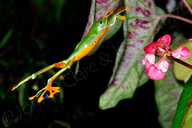|
Rhacophorus reinwardtii (Schlegel, 1840)
Reinwardt's Flying Frog, Black-webbed Treefrog, Green Flying Frog | family: Rhacophoridae subfamily: Rhacophorinae genus: Rhacophorus |
 © 2009 John P. Clare & Kurt Kunze (1 of 12) |
|
|
|
Description In the adult frog, coloration of the dorsal surface is a dark green with dark spots, fading into a golden yellow on the flank. The side also has a black band with turquoise blue spots. Webbing is black with golden yellow and bright blue spots. The underside of the frog is pure white (Inger and Stuebing 2005). Distribution and Habitat Country distribution from AmphibiaWeb's database: Indonesia, Malaysia Malaysian region distribution from AmphibiaWeb's database: Sabah, Sarawak
Life History, Abundance, Activity, and Special Behaviors It is an explosive breeder. Rhacophorus reinwardtii constructs foam nests above breeding ponds in the forest (Stuart et al. 2008). The call has been described as sounding like a low crackling chuckle (Inger and Stuebing 2005). It is speculated that the adults most likely feed on canopy insects (Inger and Stuebing 2005). Larva Trends and Threats It is dependent on relatively undisturbed mature lowland rainforest (Stuart et al. 2008). Significant loss of rain forest habitat due to logging, agricultural expansion and human settlements is the main threat to Rhacophorus reinwardtii (Ohler and Delorme 2006). This species is also threatened by water pollution, smaller-holder and agro-industry farming (Ohler and Delorme 2006). It apparently does not occur within any adequately protected areas (Stuart et al. 2008). Possible reasons for amphibian decline General habitat alteration and loss Comments Specimens from Viet Nam are now considered to belong to Rhacophorus kio (Ohler et al. 2006). This species was featured in News of the Week October 9, 2023: Large-scale phylogenies have become indispensable for many ecological, evolutionary, and conservation studies in amphibians. However, in frogs, the widely used supermatrix trees are based on relatively few genes and are quite different from recent phylogenomic trees (those based on many genes), both in relationships among families and in ages of major clades. A new study (Portik et al. 2023) has generated the largest frog phylogeny to date. This phylogeny includes 5,242 anuran species, a 71% increase in sampling relative to the previously largest supermatrix study. The new supermatrix phylogeny also incorporates hundreds of genes from phylogenomic studies, and more than twice as many fossil calibration points (for divergence dating) as the largest supermatrix study. This new phylogeny more closely resembles recent phylogenomic trees in terms of relationships among families and divergence dates. For example, the ages estimated in the new tree for some of the largest frog clades (Neobatrachia, Hyloidea, and Ranoidea) are within 20 million years of those from these phylogenomic studies, but are 56–91 million years younger than those from the previous largest supermatrix study. This new phylogeny should offer an improved estimate for use in future comparative and systematic studies. The new tree and a set of 100 bootstrapped time-calibrated trees are available here. The authors are grateful to all the researchers who published the sequence data that underlie their study. (Written by John Wiens)
References
Berry, P. Y. (1975). The Amphibian Fauna of Peninsular Malaysia. Tropical Press, Kuala Lumpur. Chan-ard, T. (2003). A Photographic Guide to Amphibians in Thailand. Krangkrai Swannapak, Bangkok. Dring, J. C. M. (1979). ''Amphibians and reptiles from northern Trengganu, Malaysia, with descriptions of two new geckos, Cnemaspis and Cyrtodactylus.'' Bulletin of the British Museum (Natural History), 34(5), 181-240. Grandison, A. C. G. (1972). ''The Gunung Benom Expedition 1967: 5. Reptiles and amphibians of Gunong Benom with a description of a new species of Macrocalamus.'' Bulletin of the British Museum of Natural History (Zoology), 23, 45-101. Inger, R. F. (1966). ''The systematics and zoogeography of the Amphibia of Borneo.'' Fieldiana Zoology, 52, 1-402. Inger, R. F. and Stuebing, R. B. (2005). A Field Guide to the Frogs of Borneo, 2nd edition. Natural History Publications (Borneo), Kota Kinabalu. Inger, R. F. and Tan, F. L. (1996). ''Checklist of the frogs of Borneo.'' The Raffles Bulletin of Zoology, 44(2), 551-574. Iskandar, D. T. (1998). The Amphibians of Java and Bali. Research and Development Centre for Biology-LIPI, Bogor, Indonesia. Ohler, A. and Delorme, M. 2006. ''Well known does not mean well studied: morphological and molecular support for existence of sibling species in the Javanese gliding frog Rhacophorus reinwardtii (Amphibia, Anura).'' Comptes Rendus Biologies 329: 86–97. Schlegel, H. (1840). Abbildungen neuer oder unvollständig bekannter Amphibien, nach der Natur oder dem Leben entworfen, herausgegeben und mit einem erläuternden. Atlas. Arnz & Co., Düsseldorf. Stuart, S., Hoffmann, M., Chanson, J., Cox, N., Berridge, R., Ramani, P., Young, B. (eds) (2008). Threatened Amphibians of the World. Lynx Edicions, IUCN, and Conservation International, Barcelona, Spain; Gland, Switzerland; and Arlington, Virginia, USA. Taylor, E.H. (1962). ''The amphibian fauna of Thailand.'' University of Kansas Scientific Bulletin, 43(8), 265-599. van Dijk, P., Iskandar, D., Inger, R., Ohler, A. 2008. Rhacophorus reinwardtii. In: IUCN 2010. IUCN Red List of Threatened Species. Version 2010.1. Species Account Citation: AmphibiaWeb 2023 Rhacophorus reinwardtii: Reinwardt's Flying Frog <https://amphibiaweb.org/species/4532> University of California, Berkeley, CA, USA. Accessed Dec 2, 2024.
Citation: AmphibiaWeb. 2024. <https://amphibiaweb.org> University of California, Berkeley, CA, USA. Accessed 2 Dec 2024.
AmphibiaWeb's policy on data use.
|




 Map of Life
Map of Life